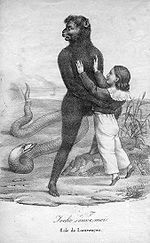
Jocko ou le Singe du Brésil
Encyclopedia

Plot
A rich Portuguese man travelling to Brazil captures a monkey which, during the Atlantic crossing, saves the man's child from shipwreck and dies in doing so. In the second production the public demanded that the monkey survive.Ballet
The play gave rise to a ballet by Frédéric-Auguste BlacheJean-Baptiste Blache
Jean-Baptiste Blache de Beaufort was a German ballet dancer and ballet master active in France....
, with music by Alexandre Piccinni and sets by Pierre-Luc-Charles Cicéri
Pierre-Luc-Charles Ciceri
Pierre-Luc-Charles Cicéri was a leading French set designer of his era....
. The ballet was first put on at the Théâtre de la Porte Saint-Martin
Théâtre de la Porte Saint-Martin
The Théâtre de la Porte Saint-Martin is a venerable theatre and opera house at 18, Boulevard Saint-Martin in the 10e arrondissement of Paris.- History :...
on Wednesday, 16 March 1825. Its main interpreters were Charles-François Mazurier and Louise Pierson.
The success of the ballet, a true bridge between the Enlightenment and Romanticism, was so great that many theatres in Paris and the French provinces put on the original version or competing works inspired by the same theme. There were over 160 productions in a single year. The Duchesse de Berry assisted in the first production in person and the success was such that many things, such as dresses, fans, hairstyles and even a type of bread were nicknamed "jocko". It was revived three times that year and had many imitators. Jules Perrot
Jules Perrot
Jules-Joseph Perrot was a dancer and choreographer who later became Balletmaster of the Imperial Ballet in St. Petersburg, Russia...
, also in 1825, put on his version at the Théâtre de la Gaîté, entitled Sapajou.
The following year, Jean-Antoine Petipa
Jean-Antoine Petipa
Jean-Antoine-Nicolas Petipa was a French ballet dancer and the father of Marius Petipa.-Life:...
put on his version at the Théâtre de la Monnaie
La Monnaie
Le Théâtre Royal de la Monnaie , or the Koninklijke Muntschouwburg is a theatre in Brussels, Belgium....
, with Laurençon in the lead rôle, Filippo Taglioni
Filippo Taglioni
Filippo Taglioni was an Italian dancer and choreographer and personal teacher to his own daughter, the famous Romantic ballerina Marie Taglioni. He is the son of Carlo and father of both Marie and Paul...
reprised the theme at Stuttgart
Stuttgart
Stuttgart is the capital of the state of Baden-Württemberg in southern Germany. The sixth-largest city in Germany, Stuttgart has a population of 600,038 while the metropolitan area has a population of 5.3 million ....
in Lanina ou le Singe brésilien and Antoine Titus put it on in Berlin.
"Jocko ou le singe du Brésil" saw a long success, even being put on the municipal theatre in Tunis
Tunis
Tunis is the capital of both the Tunisian Republic and the Tunis Governorate. It is Tunisia's largest city, with a population of 728,453 as of 2004; the greater metropolitan area holds some 2,412,500 inhabitants....
at the end of the century. It was one of the precursors for the 20th century fashion for tales of humanised monkeys like King Kong
King Kong
King Kong is a fictional character, a giant movie monster resembling a gorilla, that has appeared in several movies since 1933. These include the groundbreaking 1933 movie, the film remakes of 1976 and 2005, as well as various sequels of the first two films...
and Planet of the Apes.

